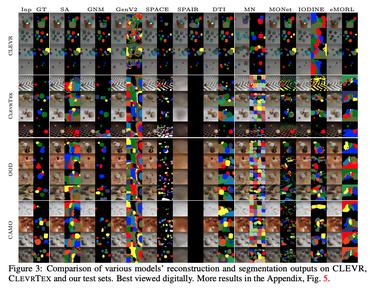Instance Segmentation
964 papers with code • 25 benchmarks • 82 datasets
Instance Segmentation is a computer vision task that involves identifying and separating individual objects within an image, including detecting the boundaries of each object and assigning a unique label to each object. The goal of instance segmentation is to produce a pixel-wise segmentation map of the image, where each pixel is assigned to a specific object instance.
Image Credit: Deep Occlusion-Aware Instance Segmentation with Overlapping BiLayers, CVPR'21
Libraries
Use these libraries to find Instance Segmentation models and implementationsDatasets
Subtasks
-
 Referring Expression Segmentation
Referring Expression Segmentation
-
 3D Instance Segmentation
3D Instance Segmentation
-
 Real-time Instance Segmentation
Real-time Instance Segmentation
-
 Unsupervised Object Segmentation
Unsupervised Object Segmentation
-
 Unsupervised Object Segmentation
Unsupervised Object Segmentation
-
 Amodal Instance Segmentation
Amodal Instance Segmentation
-
 Box-supervised Instance Segmentation
Box-supervised Instance Segmentation
-
 Image-level Supervised Instance Segmentation
Image-level Supervised Instance Segmentation
-
 Unseen Object Instance Segmentation
Unseen Object Instance Segmentation
-
 3D Semantic Instance Segmentation
3D Semantic Instance Segmentation
-
 Open-World Instance Segmentation
Open-World Instance Segmentation
-
 Human Instance Segmentation
Human Instance Segmentation
-
 One-Shot Instance Segmentation
One-Shot Instance Segmentation
-
 Semi-Supervised Person Instance Segmentation
Semi-Supervised Person Instance Segmentation
-
 Point-Supervised Instance Segmentation
Point-Supervised Instance Segmentation
-
 Solar Cell Segmentation
Solar Cell Segmentation
Latest papers with no code
PM-VIS: High-Performance Box-Supervised Video Instance Segmentation
Our PM-VIS model, trained with high-quality pseudo mask annotations, demonstrates strong ability in instance mask prediction, achieving state-of-the-art performance on the YouTube-VIS 2019, YouTube-VIS 2021, and OVIS validation sets, notably narrowing the gap between box-supervised and fully supervised VIS methods.
FisheyeDetNet: Object Detection on Fisheye Surround View Camera Systems for Automated Driving
To the best of our knowledge, this is the first detailed study on object detection on fisheye cameras for autonomous driving scenarios.
Nuclei Instance Segmentation of Cryosectioned H&E Stained Histological Images using Triple U-Net Architecture
The benchmark score for this dataset is AJI 52. 5 and PQ 47. 7, achieved through the implementation of U-Net Architecture.
FipTR: A Simple yet Effective Transformer Framework for Future Instance Prediction in Autonomous Driving
The future instance prediction from a Bird's Eye View(BEV) perspective is a vital component in autonomous driving, which involves future instance segmentation and instance motion prediction.
Performance Evaluation of Segment Anything Model with Variational Prompting for Application to Non-Visible Spectrum Imagery
Our results show that SAM can segment objects in the X-ray modality when given a box prompt, but its performance varies for point prompts.
Spot-Compose: A Framework for Open-Vocabulary Object Retrieval and Drawer Manipulation in Point Clouds
This allows for accurate detection directly in 3D scenes, object- and environment-aware grasp prediction, as well as robust and repeatable robotic manipulation.
Criteria for Uncertainty-based Corner Cases Detection in Instance Segmentation
We also present our first results of an iterative training cycle that outperforms the baseline and where the data added to the training dataset is selected based on the corner case decision function.
Benchmarking the Cell Image Segmentation Models Robustness under the Microscope Optical Aberrations
Overall, this research aims to guide researchers in effectively utilizing cell segmentation models in the presence of minor optical aberrations.
Let It Flow: Simultaneous Optimization of 3D Flow and Object Clustering
We identified the structural constraints and the use of large and strict rigid clusters as the main pitfall of the current approaches and we propose a novel clustering approach that allows for combination of overlapping soft clusters as well as non-overlapping rigid clusters representation.
Structured Model Pruning for Efficient Inference in Computational Pathology
In this work, we demonstrate that model pruning, as a model compression technique, can effectively reduce inference cost for computational and digital pathology based analysis with a negligible loss of analysis performance.


























 MS COCO
MS COCO
 Cityscapes
Cityscapes
 nuScenes
nuScenes
 ADE20K
ADE20K
 NYUv2
NYUv2
 LVIS
LVIS
 BDD100K
BDD100K
 KITTI-360
KITTI-360
 YouTube-VIS 2019
YouTube-VIS 2019
 Objects365
Objects365